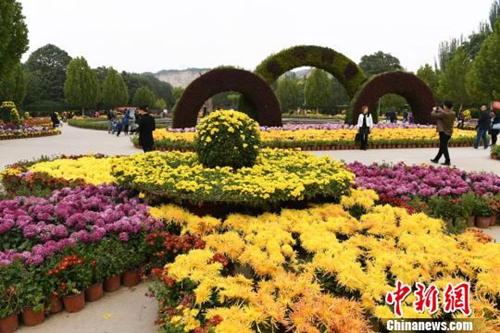Customs at the Double Ninth Festival
(chinadaily.com.cn) | Updated: 2019-01-18
Print Print[Photo/chinanews.com]
Appreciating chrysanthemums & drinking chrysanthemum wine
The Double Ninth Festival falls in autumn, when chrysanthemums blossom. It is said that the customs of appreciating chrysanthemums and drinking chrysanthemum wine originated from Tao Yuanming, a famous poet in the Eastern Jin Dynasty (317-420). Tao was famous for his seclusion, poetry and his love of wine and chrysanthemums. Posterity followed him and thus the customs prevailed. Literati and scholar-bureaucrats in old days combine chrysanthemum appreciation with the banquet to get closer with Tao Yuanming. Chrysanthemum appreciation was prevalent in Kaifeng, the capital of the Northern Song Dynasty (960-1127). There were all kinds of chrysanthemums in different poses and with different expressions. Folks called the lunar ninth month "the chrysanthemum month". At the Double Ninth Festival, when chrysanthemums are in full bloom, appreciating them is a significant event. Chrysanthemum prevailed through the Qing Dynasty (1644-1911), not only at the festival but especially in the days and weeks around it.
Wearing dogwood and chrysanthemum
The custom of wearing dogwood at the festival was already prevalent in the Tang Dynasty (618-907). According to the ancient people, wearing dogwood at the festival could help avoid difficulties and disasters. Some wore it on the arm or on the head, and some included it in the sachet and wore it inside their clothes. Usually only women and children wore it, but in some places, men wore it as well. The custom was recorded in Chang'an Anecdotes written by Ge Hong of the Eastern Jin Dynasty (317-420). Others wore chrysanthemum on the head. From the Tang Dynasty (618-907), this custom was already prevalent and it lasted long afterwards. In the Qing Dynasty (1644-1911), Beijing natives used to paste chrysanthemum leaves on doors and windows in order to pursue good fortune and avoid disasters. It was a variant of wearing chrysanthemum on the head. In the Song Dynasty (960-1279), some cut colorful silk into the shape of the dogwood and chrysanthemum.


